Amicapsil was applied on Day 0 and 1.
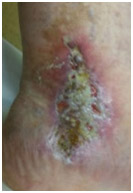 |
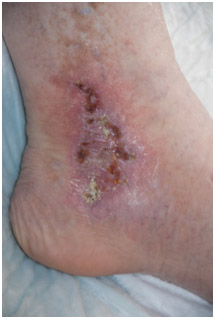 |
|
| Day -7 | Day 2 | |
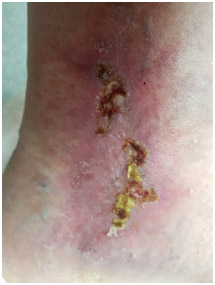 |
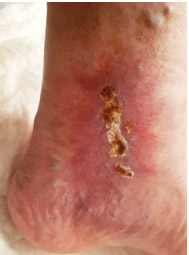 |
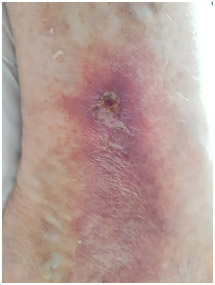 |
| Day 23 | Day 44 | Day 90 |
24 hours after the first application, the infection had cleared and the pain was halved. This measure was based on the need of pain-killers being halved. Within the subsequent 24 hours the pain reduced again to the level that only 1 dose was needed in the morning (the use up till this point in time had been 1 dose every 6 hours and that would not control the pain). Over the next days the pain continued to reduce steadily and three weeks after first Amicapsil application, the patient would need no more pain killers.
As the infection was cleared after the second application, the wound started healing with no further need of treatment.
The wound was left with a permeable contact layer dressing kept in place by stockinette. It was checked and the described dressing changed after 3, then 5, then 7 days. After that, dressing changes were performed every other week and this was then extended to every 3 weeks.
On Day 90, the patient was discharged from the GP surgery as they did not consider their supervision necessary. The wound was 2 x 3 mm, non-infected and causing no pain.
Upon first presentation at the GP surgery, the patient had been told to expect between 6 and 9 months of weekly dressing changes with full compression. He had also been warned that full healing was questionable. Amicapsil had been able to resolve the infection after two applications, the pain level began to subside immediately and the patient was discharged after 3 months.
As the conditions of the vein causing the ulcer in the first place were too severe for the skin to be able to close fully over it, the patient was referred to a cardio-vascular surgeon for evaluation. After in-depth evaluations, these assumptions were confirmed and the patient was scheduled in for surgery as the venous condition was considered too severe to prevent and/or close future ulcers. The ulcer is expected to close fully following this procedure. As the ulcer and rest of leg was no longer infected, the surgery could be scheduled in without regards to this and the potential of ensuing complications was reduced.
One month after the first Amicapsil application the patient offered the following statement:
‘It’s not too much of an exaggeration to say Amicapsil changed my life. From 4 weeks of absolute hell, in pain 24 hours a day, struggling at work and looking at possibly taking time off to being pain-free, getting a full night’s sleep and back to normal at work.’














